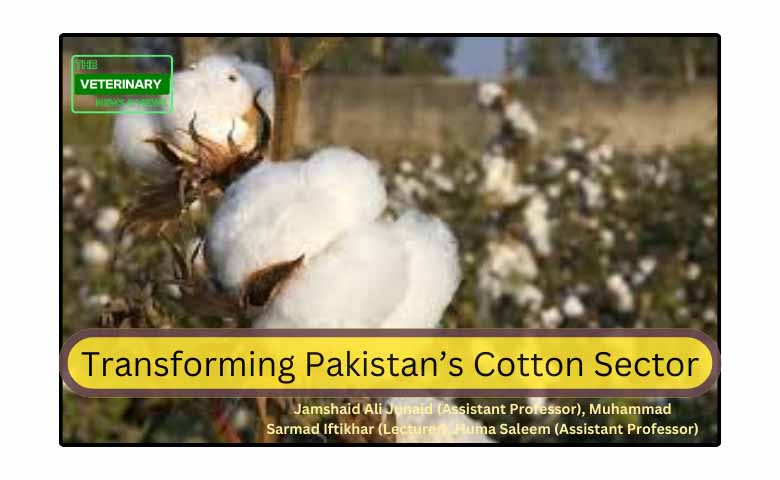Jamshaid Ali Junaid (Assistant Professor), Muhammad Sarmad Iftikhar (Lecturer), Huma Saleem (Assistant Professor)
Department of Plant Breeding and Genetics, University of Agriculture Faisalabad.

Cotton, often hailed as “white gold,” has been a cornerstone of Pakistan’s agricultural landscape and economy. From ancient times, the subcontinent has been recognized for its proficiency in cotton cultivation, fostering a legacy that transcends millennia. The fertile lands of the Indus Valley Civilization, where cotton was cultivated around 3000 BCE, symbolize the historical significance of this cash crop in the region.
As the world’s fourth-largest cotton producer, Pakistan contributes significantly to global cotton production. In 2023, Pakistan produced 5.9 million bales of cotton, each weighing 480 lbs, marking a substantial growth rate of 51.28% compared to previous years. This surge in production underscores the resilience and potential of Pakistan’s cotton industry in meeting domestic textile demands and serving as a major export commodity.
Since Pakistan’s inception in 1947, the cotton industry has undergone a remarkable evolution. Initially marked by a modest number of ginning factories, the industry has surged ahead significantly. Presently, Pakistan boasts approximately 1,000 ginning factories, with around 250 located in Sindh and over 720 in Punjab, showcasing substantial growth and modernization in the sector.
In parallel, the textile industry has seen considerable expansion, with Pakistan currently hosting 517 textile mills. These mills comprise 40 composite units and 477 spinning units, representing a robust infrastructure catering to various facets of textile production. Moreover, the country is home to approximately 28,500 shuttle-less looms and 375,000 conventional looms, symbolizing the extensive weaving capacity within the industry. Furthermore, there are approximately 700 separate or vertically integrated units with an estimated 15,000 knitting machines, highlighting the diversification and sophistication in the garment manufacturing segment.
Cotton plays a pivotal role in Pakistan’s GDP, contributing significantly to the national economy. The value addition process, encompassing spinning, weaving, and garment manufacturing, generates substantial economic growth and employment opportunities. This value addition substantially enhances the economic benefits derived from the cotton crop, translating into foreign exchange earnings through textile exports and supporting millions of jobs across the industry’s value chain.
With its significance deeply embedded in the country’s socio-economic fabric, the quest for optimizing cotton yield and quality remains a persistent pursuit. In this endeavor, the innovation of ideotype breeding emerges as a transformative approach, reshaping the way cotton is cultivated and harvested in Pakistan.
Ideotype breeding stands as a pioneering technique in agricultural science, focusing on the creation of an idealized plant model. This model possesses a specific combination of traits tailored to address the unique challenges faced by farmers in cotton cultivation. These traits encompass an array of features, including disease resistance, adaptability to varying climatic conditions, enhanced yield potential, improved fibre quality, and reduced dependency on external inputs.
The significance of ideotype breeding in the context of Pakistan’s cotton industry is multi-faceted. It presents a strategic solution to combat prevalent issues plaguing cotton farming, such as disease outbreaks, water scarcity, and pest infestations. By selecting for specific traits, this technique aims to develop cotton varieties that are better equipped to withstand these challenges, thereby elevating crop resilience and productivity.
In the diverse agricultural landscape of Pakistan, the perfect cotton ideotype encompasses a spectrum of essential traits, including disease resistance, adaptability to varying climatic conditions, enhanced yield potential, improved fibre quality, and reduced dependency on external inputs. By focusing on these traits, ideotype breeding aims to create cotton varieties that are not only high yielding but also resilient to the myriad challenges faced by farmers.
The implementation of ideotype breeding in Pakistan’s cotton sector holds the promise of revolutionizing the industry. By developing cotton varieties that are tailored to the specific needs and conditions of Pakistani farmers, this approach can significantly enhance crop performance and sustainability. Moreover, the adoption of ideotype breeding can lead to a reduction in the use of chemical inputs, promoting environmentally friendly farming practices and contributing to the overall health of the ecosystem.
In conclusion, ideotype breeding represents a transformative approach to cotton cultivation in Pakistan. By harnessing the power of this innovative technique, the country can achieve substantial improvements in cotton yield, quality, and resilience. As Pakistan continues to advance in the global cotton market, the adoption of ideotype breeding will play a crucial role in ensuring the sustainability and prosperity of its cotton industry for generations to come.